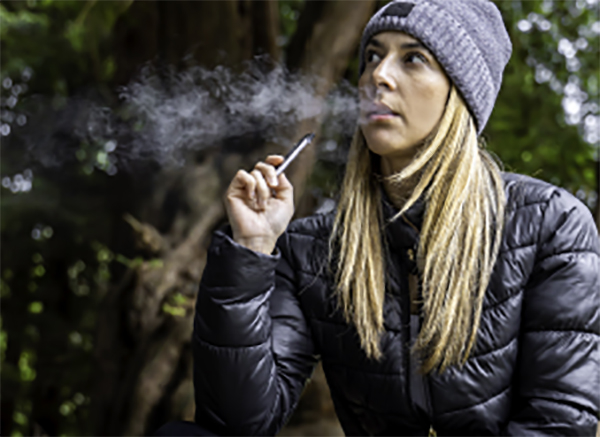Action needed on e-cigarettes
Following years of successful tobacco control efforts that achieved record low youth smoking, e-cigarettes have driven total youth tobacco use to rates unseen in decades. Current, or past 30-day, use of e-cigarettes among high school students increased from 11.7% to 27.5% between 2017 and 2019, driving overall tobacco use among high school students to 31.2%. The most recent data from 2020 show that high school students continue to use e-cigarettes at epidemic levels, with 1 in 5 (19.6%) vaping in the past 30 days, and that the intensity of use has increased with 38.9% of current users reporting vaping on 20 or more days per month.
The Food and Drug Administration has taken only tentative steps to remove some youth-appealing products and flavors. In the absence of comprehensive federal regulation, many flavored e-cigarettes remain on the market and sales data indicate that young people simply switch to products that are still available. Meanwhile, evidence is mounting that links e-cigarette use among young people with subsequent cigarette use. A 2020 Truth Initiative study shows that young Americans who had ever used e-cigarettes had seven times higher odds of becoming smokers one year later compared with those who had never vaped.
Despite the tobacco industry’s insistence to regulators that e-cigarettes are intended for and marketed to adult smokers, the data show that youth and young adults continue to vape at the highest rates. While youth use of e-cigarettes reached 20.8% in 2018, the National Health Interview Survey found in the same year that only 3.2% of adults use e-cigarettes – much of that driven by young adults, who use at 7.6%. A recent Truth Initiative study also found that very few adult smokers are using e-cigarettes to try to quit. Among adult smokers who tried to quit in the last year, just 1.1% used JUUL alone and only 5.6% used other e-cigarettes alone. The study found that among former smokers who had quit in the past four years, just 2.2% reported using only JUUL and 6.9% used other e-cigarettes. While some adults have used e-cigarettes to switch completely from combustible cigarettes, the FDA has not approved any e-cigarette as a cessation intervention, and nearly half of adults who use e-cigarettes also use cigarettes. This “dual use” provides no reduction in the harms associated with smoking.

Young Americans who had ever used e-cigarettes had seven times higher odds of becoming smokers one year later compared with those who had never vaped.
In an era when brand names of e-cigarettes have become verbs (e.g. “JUULing”), much work remains for federal, state and local governments to establish comprehensive policies to protect youth from highly addictive nicotine-containing products like e-cigarettes. Immediate action is needed, including removing all non-tobacco flavors from the market, ensuring a thorough and transparent FDA review of all products, and placing restrictions on e-cigarette marketing, among other regulatory measures that will help protect youth from a lifetime of nicotine addiction.
11 Years of Delays: A Brief Regulatory History of E-cigarettes
The 2009 Tobacco Control Act gave FDA the necessary tools to reduce society’s toll from tobacco, including e-cigarettes. However, the agency has repeatedly failed to use its powers to slow – or even prevent – the youth e-cigarette epidemic. Indeed, until very recently, e-cigarette manufacturers enjoyed a market with few barriers.
While Congress expressly gave FDA the responsibility to regulate tobacco products in 2009, repeated regulatory delays gave e-cigarette manufacturers 11 years to operate with minimal federal oversight. First, FDA took seven years to officially bring e-cigarettes under its jurisdiction following the passage of the Tobacco Control Act in 2009. During that time, there were no federal regulations on e-cigarettes. In 2016, when FDA finally “deemed” e-cigarettes as part of its jurisdiction, it gave e-cigarettes that were currently on the market two years to prepare premarket applications (known as PMTAs). FDA requires these applications to determine whether new tobacco products are “appropriate for the protection of public health” before they are allowed on the market.
The deadline for e-cigarette pre-market applications faced four additional years of delays. In 2017, FDA extended the deadline for completed applications to August 2022. When several public health groups, including Truth Initiative, sued FDA, a federal court ordered the agency to require applications be submitted by May 2020. The deadline changed again to September 9, 2020, following FDA and tobacco industry requests for more time due to the COVID-19 pandemic.
At long last, after finally facing a deadline for e-cigarette manufacturers to submit applications, FDA has begun reviewing thousands of applications to determine if those products meet the public health standard set by the Tobacco Control Act. While the agency is supposed to conduct its review of those products in one year, FDA’s Center for Tobacco Products director has admitted “the likelihood of FDA reviewing all of these applications during the one-year review period is low,” foreshadowing yet more delays in necessary and urgent regulatory action.
REMOVE ALL NON-TOBACCO FLAVORED E-CIGARETTES, INCLUDING MENTHOL
FDA must act to remove all non-tobacco flavored e-cigarettes, including menthol flavors, from the market. Federal actions to date to limit the marketing of e-cigarettes, including removing some pod-type flavored e-cigarette products, have proven insufficient to significantly reduce the alarming number of young people who use e-cigarettes.
For example, FDA announced in January 2020 that it would remove all flavored, pod-based e-cigarettes except for menthol and tobacco flavors. This partial measure left not only menthol-flavored pods on the market, but all flavors of e-cigarette liquid, or “e-juice.” It also exempted disposable flavored e-cigarettes – a relatively new sector within the category at the time. The tobacco industry quickly exploited these loopholes. By May 2020, menthol e-cigarettes accounted for more than half (51.6%) of e-cigarette sales and 37% of youth e-cigarette reported using menthol e-cigarettes. Disposable e-cigarette sales increased from 10.3% of the market in August 2019 to 19.8% in May 2020, and use of disposable e-cigarettes among high school students increased an astounding 1000% in that timeframe.
The policy simply moved young consumers from one product to another. It is clear that without a full removal of all flavored products from the market, reversing the youth e-cigarette epidemic will be stymied.

FDA must act to remove all non-tobacco flavored e-cigarettes, including menthol flavors, from the market.
ENSURE A THOROUGH AND TRANSPARENT PRE-MARKET REVIEW PROCESS
After many years of delays (see sidebar: “A Brief Regulatory History of E-cigarettes”), e-cigarette manufacturers faced a deadline of September 9, 2020 to submit pre-market applications to FDA. The agency is now reviewing applications to determine whether the products can remain on the market. Only certain products that were on the market prior to August 2016 (before FDA had jurisdiction over e-cigarettes) will be allowed to stay on the market for an additional year while FDA reviews these applications. All other products for which companies did not submit PMTAs are now on the market illegally and must be removed immediately.
FDA needs to be transparent about both the review process and its enforcement of the regulations against those products and companies who are operating outside of the existing regulatory structure. Specifically, FDA should release on a regular and timely basis a list of those manufacturers who have filed PMTA applications including the names of products submitted, status of their acceptance by FDA, and other information to keep the public informed about this critical review process. Without such information, consumers, parents, retailers, lawmakers and the public health community have no way of knowing which products are even attempting to follow the regulatory process and no way of holding FDA accountable for doing its job.
Product review is only the first step. FDA’s actions cannot and should not stop with the pre-market review process.
RESTRICT E-CIGARETTE MARKETING TO ENSURE IT IS AIMED AT ADULTS
The marketing tactics of the tobacco industry have played a significant role in attracting youth to e-cigarettes. The products, which come in a wide variety of fruit, candy and alcohol flavors that appeal to young people, are advertised with themes that the tobacco industry has successfully used to attract youth for decades. The industry has also employed a variety of paid media efforts, such as extensive social media and experiential event campaigns featuring young influencers, to attract youth.
FDA has indicated that it will impose restrictions on social media marketing and encourage e-cigarette advertising to be aimed at adults. We urge FDA to move forward with imposing those restrictions expeditiously for all e-cigarettes so that the restriction is already in place prior to any product being authorized for sale in the U.S.
The need for this action is clear as there are numerous examples of e-cigarettes that are advertised and packaged in a manner that is clearly youth-appealing. FDA has taken action against some of the most blatant products, but this has been a piecemeal, reactive approach. For example, in July 2020, FDA sent warning letters to seven manufacturers ordering them to remove their flavored disposable e-cigarettes from the market because their marketing was targeted to youth or likely to promote use by youth. Egregious marketing examples cited in the letters included using cartoon images or imitating food products that appeal to children, such as churros or other baked goods; popcorn and Cracker Jack ; or breakfast cereals.
These sporadic actions have not resulted in the removal of the myriad products that clearly target youth. For example, despite its warning letter to the makers of Puff Bars, as well as that company’s announcement that it would cease doing business in the U.S., sales data through October 2020 continue to show substantial sales for the brand in monitored retail channels.
FDA must exert its considerable enforcement authority to protect youth and young adults from all nicotine containing products before they enter the market, and ensure swift and fulsome follow through in enforcement for those that flagrantly disregard the rules.

The marketing tactics of the tobacco industry have played a significant role in attracting youth to e-cigarettes.
COMPREHENSIVE ACTION NEEDED
- Much more needs to be done to ensure that e-cigarettes do not attract youth, and are actually helping adult smokers switch from cigarettes completely. State and local governments also can further protect their residents from these products.
- We have outlined a comprehensive set of actions that are needed at the federal, state and local levels to best protect public health and ensure that the tobacco industry does not continue to addict another generation of our nation’s youth.
FEDERAL ACTION NEEDED
- Ensure illegal products that did not submit PMTA applications are removed from the market immediately. This process should be made public.
- FDA must promptly ensure that the PMTA process is transparent – and supply the public with information about industry compliance with, and FDA enforcement of the process. The FDA has indicated it will supply a list of products for which applications have been submitted. We strongly urge FDA to make that list available rapidly and to include public documentation of all actions FDA takes with regard to PMTA applications.
- Marketing: FDA must restrict e-cigarette marketing so that it does not target or appeal to youth.
- Specifically, the agency must immediately impose the same marketing restrictions on e-cigarettes that it imposes on combustible cigarettes. These include prohibitions on:
- Sponsorships of sports and cultural events
- Self-service access to the products (i.e. keeping the products behind the counter)
- Free gifts with purchase, other than tobacco products (i.e. no free branded t-shirts or hats with purchase)
- Social media and influencer marketing restrictions: FDA has indicated that it will review and institute restrictions on social media and influencer marketing (ensuring that marketing avoids images and themes that appeal to youth; that the marketing focuses on appealing to adults such as using “switching” themes, using older models; etc.) and restrictions on paid digital and social marketing and the use of influencers to limit youth exposure to advertising. We urge FDA to follow through and apply such restrictions to all e-cigarette products immediately.
- The Federal Trade Commission (FTC) monitoring: must also ensure that all industry-funded influencer endorsements clearly indicate that they are paid advertisements and clearly indicate the risks associate with nicotine use. The FTC must collect data from the e-cigarette industry on all marketing spending just as it does for cigarettes and smokeless tobacco.
- Specifically, the agency must immediately impose the same marketing restrictions on e-cigarettes that it imposes on combustible cigarettes. These include prohibitions on:
- Product standards: FDA has the ability to institute product standards on e-cigarettes, preventing the sale and marketing of any product that does not adhere to those standards. This is a powerful tool the agency needs to exercise in several areas:
- Flavor restrictions: Truth Initiative has long supported the removal of flavors, including menthol, in cigarettes, cigars and smokeless tobacco. We know that flavors have overwhelming been used to attract youth and those who have not previously used nicotine or tobacco. Given the youth e-cigarette epidemic and the role that flavors play in influencing youth to use e-cigarettes, we strongly support removing all flavored e-cigarettes from the market, including mint and menthol, as well as any “concept” flavors or other ambiguously named or packaged products that are flavored. We support a permanent ban on flavored tobacco unless a manufacturer can demonstrate three things to the FDA: 1) that a particular flavor helps current tobacco users to switch completely to a substantially less hazardous product, 2) the flavor will not lead non-tobacco users, such as youth, to start, and 3) the flavor itself does not increase the risk of harm from using the product.
- Product packaging: FDA should issue product standards so that e-cigarettes, and e-liquid in particular, come only in child-resistant packaging to prevent young people from ingesting these products, which cause sickness and, in some cases, can be fatal.
- Restrictions on nicotine concentrations and delivery: Currently FDA does not impose restrictions on the concentrations of nicotine in e-cigarette products in the U.S. JUUL, the most popular e-cigarette in the U.S., contains 59 mg/ml (or 5%) nicotine and has recently introduced a 3% concentration. Other e-cigarette brands, such as popular disposable brand Puff Bar, claim to have just as much and other competitors claim to have 6-7% nicotine. This is in stark contrast to the European Union, where the highest nicotine concentration allowed is 20 mg/ml (2%). Truth Initiative supports restricting not only nicotine levels, but also the mechanism by which nicotine is delivered (e.g. restrictions on levels of nicotine salts), to reduce the amount of nicotine e-cigarettes deliver to the body. These restrictions will help reduce the addictiveness of the products.
- Enforcement: In addition to enforcing the PMTA requirements, the FDA must use its powerful enforcement authorities to ensure that all aspects of the Tobacco Control Act, as well as all subsequent regulations, are enforced in a timely manner to the full extent of the law. Without enforcement, these hard-fought measures are meaningless and will not protect youth. Additionally, other federal agencies, such as the FTC, should continue working with FDA to protect against misleading marketing.
- Internet sales: FDA should prohibit all non-face-to-face sales, along with internet sales of all tobacco products, including e-cigarettes.
- Taxation: Federal, state and local tax-writing authorities should set taxes on e-cigarettes at a level sufficient to discourage youth use.
- Cessation: Federal agencies such as FDA and National Institutes of Health (NIH) must redouble all efforts to develop nicotine cessation interventions for the millions of youth and young adults who now find themselves addicted to nicotine from e-cigarette use. Additionally, the Centers for Medicaid and Medicare Services and insurance companies should make quitting services and interventions available for all those addicted to nicotine – whether from e-cigarettes or combustible tobacco products – with no barriers to treatment.
- Federal research: FDA and NIH must fund research to better understand harms associated with e-cigarettes, behavioral use patterns, and impact on tobacco cessation (separate from the research mentioned above).

Tobacco 21 policies must be accompanied by complementary and strong policies.
STATE AND LOCAL ACTION NEEDED
States and local communities are often the incubators of strong tobacco control policies and they have an important role to play in protecting youth from e-cigarettes. Some examples include:
- Licensing: Requiring all e-cigarette vendors to be licensed and registered with the state or local (where allowed) government. Licensing is not only an important way to keep track of who is selling tobacco products, it can also be a tool to limit the density and location (i.e. not near schools) of tobacco retailers. For more information on the importance of tobacco retail licenses please see our Point of Sale Policy Resource.
- Flavor restrictions: Many local jurisdictions have taken action to restrict or prohibit the sale of flavored tobacco products. Truth Initiative supports such actions because they limit the availability of highly appealing tobacco products for youth.
- Clean Indoor Air: State and local governments should include e-cigarettes in their clean indoor air laws and requirements.
- Tobacco 21: While a federal Tobacco 21 law passed in 2019, state and local jurisdictions (where allowed) should limit sales of all tobacco products, including e-cigarettes and their components, to those 21 and older, with the onus on the retailer to comply. We note that the tobacco industry has supported Tobacco 21 policies, selling the idea that this policy will take care of the youth tobacco problem. While Tobacco 21 is an important tool in the tobacco control toolbox, by itself it is not sufficient to keep tobacco out of the hands of young people. Tobacco 21 policies must be accompanied by complementary and strong policies, including but not limited to those listed above.
More in emerging tobacco products
Want support quitting? Join EX Program
By clicking JOIN, you agree to the Terms, Text Message Terms and Privacy Policy.
Msg&Data rates may apply; msgs are automated.




